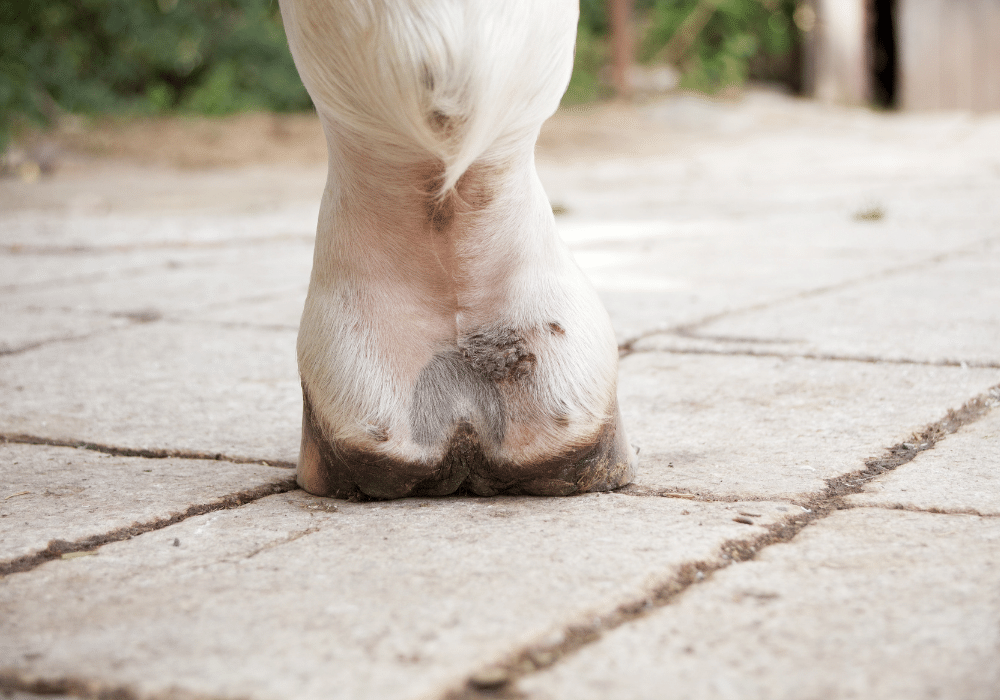Mud fever is a stubborn, unsightly and uncomfortable condition that tends to affect horses during the winter months. Whilst mud fever can be difficult to treat effectively, preventing mud fever is possible. Our blog article outlines the steps horse owners can take to prevent mud fever this winter.
What is Mud Fever?
Mud fever is a general term used to describe a skin infection that usually affects the horse’s lower legs. Sometimes known as pastern dermatitis or greasy heel, mud fever can be caused by bacteria, fungus or mites.
Mud fever usually occurs during the wet winter months, but it can also occur at other times of the year. The condition occurs when the skin becomes damaged and gets infected.
Mud Fever Symptoms
The symptoms of mud fever are recognisable: reddened skin, hair loss and scabs covering the affected area are characteristic of mud fever. In more severe cases, pus may be seen oozing out from under the scabs. The leg may also become swollen and painful. Left untreated, mud fever can spread further up the leg and cause lameness.
Preventing Mud Fever
Preventing mud fever relies on good management. By preventing the initial infection, it is possible to keep the mud fever at bay.
Effective Pasture Management
Mud fever – hence the name – tends to occur when the fields turn muddy during the long, wet winter months. The constant exposure to wet, muddy conditions causes the skin to weaken, and this allows the bacteria to infect the skin. One way of reducing the chance of mud fever occurring is by trying to prevent fields from becoming excessively muddy and boggy.
High traffic areas, such as gates, water troughs and feeding areas tend to get muddy very quickly. If possible, put some kind of surface down in these areas. You may also be able to rotate where you place the food, so one area is not becoming too churned up.
You may also need to adapt your turnout routine to allow the field to rest. You could also divide the field into sections and rotate which section is used for grazing.
Keeping Horses’ Legs Clean & Dry
Clean dry skin is less likely to get infected than wet, muddy skin. Whilst it is tempting to hose the horse’s legs off every day, this can actually make the problem worse.
It may be best to wait for the mud to dry before brushing it off. Alternatively, if you do need to wash the horse’s legs, allow them to dry completely before turning them out again. You may need to use towels or even a hairdryer.
For some horses, clipping their feathers off may help to prevent mud fever from taking hold as it allows you to easily see and clean the lower legs. However, you may also find that the feathers protect the skin from damage in the first place. Seek advice from your vet if you are unsure.
Barrier creams and turnout boots may also help keep the legs clean and dry. However, it is important to check that you are not actually making the problem worse by creating a damp, anaerobic environment in which the bacteria thrive. If you use turnout boots, change them regularly as they will become wet and muddy.
Minimising Damage and Injury to the Skin
Effective pasture management and keeping your horse’s legs clean and dry will help to minimise the chance of the skin becoming damaged and infected. However, there are additional steps you can take to keep the mud fever at bay.
Check your horse’s legs daily. Even if they aren’t being ridden or they don’t usually suffer from mud fever, checking their legs will help you to spot any symptoms early. If you spot any cuts, hair loss or other symptoms, contact your vet for advice.
If your horse wears exercise boots, check that they are not rubbing. This can damage and irritate the skin, making it more susceptible to infection. Always ensure any boots your horse wears are clean, dry and fit properly.
Avonvale Equine Vet Practice
Our experienced and highly qualified equine vets are always happy to advise clients on preventing and managing mud fever and other ailments. Our vets are on call 24 hours a day, seven days a week for emergencies, and we also offer a weekly zone visits scheme for routine appointments. If you are looking for a dedicated, independent equine vet practice, register with us today.








